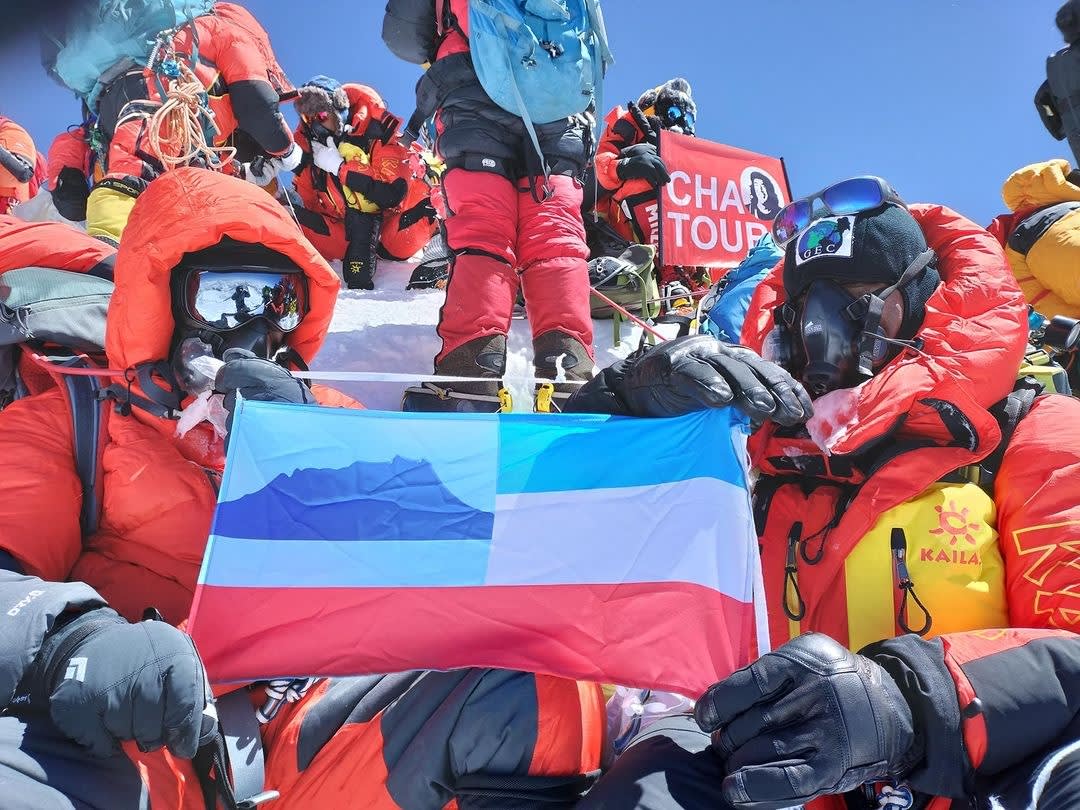He lost 8 fingers to Everest. But it didn't deter this Malaysian from making a 3rd attempt to scale the peak
CNA spoke to Ravichandran Tharumalingam after his successful summit attempt on May 5. He described the achievement as a way to “conquer old demons”.

Malaysian climber Ravichandran Tharumalingam was slammed for not thanking the Sherpa who rescued him from Mount Everest's ‘death zone’. (Photo: Instagram/ravieverest)
KATHMANDU: Malaysian climber Ravichandran Tharumalingam recalls his excruciating expedition in 2007.
The then-42-year-old was so keenly focused on summiting Mount Everest for the second time in two years that his euphoria distracted him from a slight tingling sensation in his fingers.
He had successfully reached the mountain's peak for the first time in 2006.
Ravichandran or Ravi as he prefers to be called, eventually reached the top of the world’s highest mountain once more, but this time at a cost. The tips of eight of his fingers had to be later amputated due to frostbite.
“I believe it was something to do with (prioritising) desire over being rational. I was so desperate to prove a point, I was pushing myself too much that I ignored the pain in my fingers,” he recounted.
Ravi was unaware that his gloves had torn, exposing his fingers to the stinging cold.
“At the back of my mind, I was hoping the sensation in my fingers would go away as the temperature got warmer and the sun rose higher, but this never happened. My fingers were beyond recovery,” he added.
Fifteen years after that fateful incident, Ravi, now 57, has made a triumphant return to Mount Everest.
On May 5, Ravi reached the summit for the third time in his life, and the first since his previous attempt left him disfigured.
Speaking to CNA via a virtual video interview from Kathmandu, the Malaysian climber described how his latest Everest summit “was the best moment” in his life.
Completing this year’s expedition, a challenge he named Everest 3.0, was an opportunity to “conquer old demons,” he said.

“Every time you go back to places that make you feel dark in your thoughts, and (you) overcome the challenges better, it gives you a brighter space and brighter view.
“Coming back to Everest this year, it gives me a clearer view of who I am and the confidence I have,” he added.
Ravi, who was also the guide for two other climbers this year, recalled how the last 20 to 30 steps to the summit gave him “a good sense of accomplishment and satisfaction”.
He made the climb alongside one of his clients, fellow Malaysian N Elanghovan, 64, who was attempting his first summit of Mount Everest.
Ravi described this year’s expedition as “smooth” because it took his two clients and him less than a month to complete. His previous attempts in 2006 and 2007 took between 45 and 60 days.
He was also grateful for good weather, and his team took advantage of the relatively low winds for their summit push.
“The only thing that bothered me this year is that I felt frostnip at the front parts of my (severed) fingers. A couple of my fingers are still swollen and I believe this is due to the cold and exposed tissue and bone,” he added.

The discomfort he felt in his severed fingers prompted him to complete his climb with supplemental oxygen.
Supplemental oxygen is typically used by climbers at higher altitudes, as it helps prevent hallucinations and pulmonary edema due to the dangerously thin air. Initially, Ravi had planned to summit Mount Everest without supplemental oxygen this year.
“I made a good decision. Putting on oxygen was the right move. I learnt from the mistakes on the previous trips,” said Ravi.
FEWER CLIMBERS BUT STILL ENCOUNTERED HUMAN TRAFFIC JAM
Before the COVID-19 pandemic, various news outlets reported in 2019 how climbers faced human traffic jams en route to the summit.
A photo captured by Nepali mountaineer Nirmal Purja Magar showed a continuous line of hundreds of climbers bottlenecked on the summit ridge of Everest. The climbers were all trying to take advantage of a narrow window of good weather.
The issue prompted discussion within the climbing community on the dangers of overcrowding at such high altitudes.
In his May 5 climb, Ravi said he and his team encountered a “mild traffic jam” at Hillary Step, the rock face near the peak of Mount Everest, albeit the queue up to the summit moved slowly with only a few climbers cutting the line.
“We have been keeping track of the number of permits approved and from the information we got, around 200 people got permits to climb in 2022. This was less than in 2019, when around 600 permits were issued,” he said.
“We were not expecting a traffic jam, but there was a bit (near Hillary Step). But everybody was moving and the technical abilities of the climbers were fantastic this year. We were queuing but never stationary,” added Ravi.
When asked about his future climbing plans, Ravi said that he was already preparing for Everest 4.0, and has posted on Facebook to persuade climbers to sign up with his team to summit Mount Everest in 2023.
However, he said that he must first work with doctors in Malaysia to “do a proper amputation” of his eight severed fingers (four fingers of both his left and right hands).
He explained that based on consultation with doctors in Nepal after his recent climb, he experienced difficulty with frostnip because the bones on his severed fingers were exposed.
“I’m willing to go through this painful process again, to remove the tissue, grind the exposed part of the bones, pull back the tissue and stitch them up,” said Ravi.
“I will lose another few millimetres from each of my fingers but I believe that after the amputation process, I’ll be able to take up the challenge of climbing without supplemental oxygen next year,” he added.
“I believe every human being will encounter his or her own setbacks. Mine happens to be losing fingers,” said Ravi, adding that the processes of overcoming setbacks make him stronger.
Read this story in Bahasa Melayu here.















